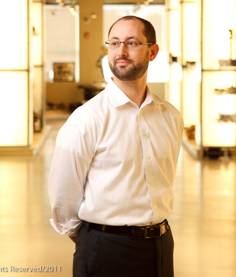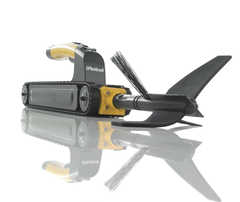
Name Chris Jones
- Education Ph. D. in Computer Science, B.S. in Computer Engineering
- Target Audience Undergraduate

Robots are not just a thing of science-fiction. Robots are in places you might not expect, whether they are helping people around the house or traveling to Mars. Read on to find out why people who work in robotics, like Dr. Chris Jones, have such cool jobs!
In my role as Director for Research Advancement I manage a group of scientists and engineers who are tasked with defining and executing research projects that push the state-of-the-art in robotics. Our team is a multidisciplinary group with different backgrounds - computer scientists, mechanical engineers and electrical engineers - who all bring unique perspectives to our projects. This cross-disciplinary nature is important for robotics because robotics tend to bring all of those things together. Our team brainstorms new ideas and we work with academic partners and researchers to find interesting and novel directions to push robotics. In general, we get to create new and valuable capabilities in robotics. The job involves a lot of creative brainstorming and idea generation and the fun part comes when we actually get to execute those projects and develop potential next generation robots.
Growing up I had always been interested in science and engineering. I was one of the kids who was always taking things apart and putting them back together, as well as building completely different things. My dad is an electrical engineer and he introduced me to computer programming when I was very young, around age 10. Computer programming was easy and enjoyable for me and led me to computer engineering by the time I entered college at Texas A&M. It wasn't until I found myself talking to my undergraduate advisor, however, that I was introduced to the field of robotics. After completing an internship that I wasn't thrilled about at a large company, I remember telling my academic advisor that I no longer knew what I wanted to do. He encouraged me to go talk to a professor in the computer science department named Nancy Amato, and this conversation turned out to be a career changing event.
Nancy gave me an undergraduate research position where I worked with her on some of the robotics problems she was researching. Her passion and mentorship really got me excited about the work that we were doing in robotics. Her mentorship also got me into an internship and ultimately a full-time job doing robotics work. After working in the field for a couple of years I went back to school to get my Ph. D. and now I'm at iRobot. It was that moment when my undergraduate advisor referred me to Nancy that brought everything together. I credit her for giving me a creative outlet for my science and engineering interests in college.
As with most jobs, there are the day-to-day financial tracking and people management aspects, but a good chunk of my time, fortunately, is spent trying to generate, develop, and mature new ideas - from coming up with new ideas for research agendas or directions to developing those ideas and getting them down into written proposals. My job allows me to watch these projects develop, understand what the challenges are, and a) view a challenge as an opportunity to propose a new research agenda, or b) take the positive outcomes of the research and try to find ways to push them forward in order to mature the technologies to the next step.
 We had a sponsor come to us who was looking to build soft robots. This sponsor was interested to see if it was at all possible to build a robot that was completely soft and squishy. It had never really been done before, so we were looking at a variety of different approaches. For this project we teamed up with physicists from the University of Chicago who had never worked in robotics before, but they did have interesting background knowledge in the field of particle physics and a physical process called "jamming." Jamming deals with the question of how particulate matter, like sand, moves when it is interacting with other grains of sand, and in particular what happens when a granular material is exposed to a vacuum. Think about a bag of vacuum-packed coffee that is very hard and rigid. The coffee grounds become a jammed material. It is a very rigid object that is made up of a bunch of little coffee ground particles. So we teamed up with these physicists to implement this capability in building a soft robot - one that could be soft when it needs to be but also become rigid when it needs to be.
We had a sponsor come to us who was looking to build soft robots. This sponsor was interested to see if it was at all possible to build a robot that was completely soft and squishy. It had never really been done before, so we were looking at a variety of different approaches. For this project we teamed up with physicists from the University of Chicago who had never worked in robotics before, but they did have interesting background knowledge in the field of particle physics and a physical process called "jamming." Jamming deals with the question of how particulate matter, like sand, moves when it is interacting with other grains of sand, and in particular what happens when a granular material is exposed to a vacuum. Think about a bag of vacuum-packed coffee that is very hard and rigid. The coffee grounds become a jammed material. It is a very rigid object that is made up of a bunch of little coffee ground particles. So we teamed up with these physicists to implement this capability in building a soft robot - one that could be soft when it needs to be but also become rigid when it needs to be.
We did not originally know much about this simple physical phenomenon, but given this new knowledge we can see how its potential can be applied to other areas of robotics that we have had challenges with in the past. For example, particle jamming brought a very simple, elegant and innovative solution to robotic grasping. The field of robotics that had been building very complex multi-fingered hands for robots that are able to pick things off a table or open a door, but the technology is very complex, expensive and hard to build. Utilizing particle jamming technology solves a lot of those expensive and complex issues.
The most enjoyable part is being able to be presented with a new challenge or need and try to figure out how to piece together new and existing technologies that will result in a valuable advancement in robotic technology and capability.
Computer programming was an important part of my life from a very young age. In high school I gained valuable experience through my participation in an organization called Destination Imagination, which was an extracurricular program geared to help kids develop skills in creative problem solving and engineering. A team of students was put together and given a variety of challenges they needed to overcome. One challenge was finding a solution to a long-term engineering problem, such as building a balsawood structure that holds the most weight. The team had a number of months to come up with the best design. Upon completion, each team participated in a competition during which they had a second challenge to overcome by putting on a creative theatrical performance that hopefully communicated a broader message surrounding the team's approach or the context surrounding the general problem. On the day of the competition each team was given a third challenge involving spontaneous problem solving. Each team would be given a problem, on the spot, and have a limited amount of time to solve it. The problem could be a verbal or language type of problem or an engineering type of problem. Participating in this program was very important for me, as it taught me to work as part of a team to solve many engineering and performance arts challenges.
I think the most challenging thing for me was that I had a hard time getting motivated for class work. Working on calculus problem after calculus problem or repetitive chemistry homework was hard for me when the lessons weren't tied to any particular real-life application. Keeping good grades in that kind of coursework was very difficult. Things like Destination Imagination or getting involved with research activities in college helped bring all of that knowledge together and gave me a much more integrated view on why all that coursework in calculus and engineering was important. I was, and still am, highly motivated by the concrete application of knowledge to real-life scenarios.
Find your way into research activities as an undergraduate. I became involved with research projects early in my undergraduate career because I wanted to gain research experience, and learned what it would be like to work in the research field at the graduate and professional level. The earlier you can get exposed to and become familiar with an environment, the easier it is to jump into that environment when the time comes.
 There certainly will be a lot of changes. There is a very emerging market for robotics, as well as a very rich academic research environment. Robotics will be always be fairly unique in that it brings together many disciplines - electrical engineering, mechanical engineering, system engineering, computer science and even psychology gets pulled in to help figure how robots can interact with people around them. One area that will probably grow the most or show the most impact is computer science. We are going to start seeing more sophistication and increased capabilities being put into robots through the addition of intelligent software.
There certainly will be a lot of changes. There is a very emerging market for robotics, as well as a very rich academic research environment. Robotics will be always be fairly unique in that it brings together many disciplines - electrical engineering, mechanical engineering, system engineering, computer science and even psychology gets pulled in to help figure how robots can interact with people around them. One area that will probably grow the most or show the most impact is computer science. We are going to start seeing more sophistication and increased capabilities being put into robots through the addition of intelligent software.
I would definitely encourage kids to get involved in STEM fields, robotics in particular. For me personally, and I think for many similarly minded people, it is a very satisfying field because of its multi-disciplinary nature. I also love that robotics requires a certain amount of creative thinking, and the result of that creativity is something very tangible. There is nothing more satisfying than seeing a long-term research project turn into a practical robotic solution that solves a real need in the world. At iRobot we see the technology and capabilities we've developed used in robots that are saving people's lives or creating practical value for folks in their homes.
Movies and cartoons may make Robotics seem like science-fiction, but today we are seeing tremendous growth in the field. Robots are becoming main-stream very quickly and what used to be a dream is quickly becoming a reality. It's great for kids to get excited about robotics early and start applying themselves to see the applications of science and math in an actual physical form. It's a very satisfying field.
 Robots have often been used to travel where human beings can't. Robots like the Mars Curiosity explore the surface of other planets, while other robots like the iRobot Seaglider explore the seas.
Robots have often been used to travel where human beings can't. Robots like the Mars Curiosity explore the surface of other planets, while other robots like the iRobot Seaglider explore the seas.
Taylor Barg is a senior mechanical engineering and math major at SMU, a…
Do you have what it takes to be an antarctic engineer? Jim O'Sullivan d…
Who keeps robots running? The Robotics Technicians, that's who! These …